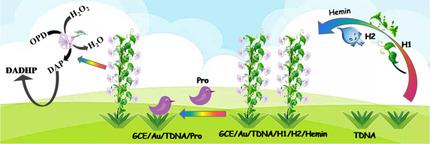当前位置:
X-MOL 学术
›
Electroanalysis
›
论文详情
Our official English website, www.x-mol.net, welcomes your
feedback! (Note: you will need to create a separate account there.)
Target‐stimulated DNAzyme Concatamers Released from Aptasensor for Highly Sensitive and Specific Detection of Progesterone
Electroanalysis ( IF 2.7 ) Pub Date : 2019-11-14 , DOI: 10.1002/elan.201900440 Weiping Shi 1 , Bingqian Liu 1
Electroanalysis ( IF 2.7 ) Pub Date : 2019-11-14 , DOI: 10.1002/elan.201900440 Weiping Shi 1 , Bingqian Liu 1
Affiliation

|
Aiming at the detection of ultralow concentration target progesterone (Pro), a novel electrochemical aptasensor based on DNAzyme concatamers signal amplification strategy was proposed. The strategy consists of target DNA strands (TDNAs), and two different hairpin DNA molecules (H1 and H2). The signal is amplified by the large amount of DNAzyme. The TDNAs modified on the electrode open H1 structures in sequence and propagate a reaction of hybridization events between two alternating hairpins (H1and H2) to obtain abundant DNAzyme concatamers. Upon target Pro introduction, a specific Pro‐TDNAs reaction was executed, thereby resulting in the release of DNAzyme concatamers from the electrode. Subsequent differential pulse voltammetry(DPV) detection of aminoazobenzene (DAP) resulting by DNAzyme catalyze the oxidation of o‐phenylenediamine (OPD) with the aid of hydrogen peroxide (H2O2). Likewise, a small amount of target Pro can efficiently induce the release of a large number of the DNAzyme from the electrode in the form of DNAzyme concatamer. Under optimal conditions, the the proposed assay presents good electrochemical responses for determination of target Pro in the range of 0.5 to 15 ng/mL with the detection limit of 0.36 ng/mL. In addition, the resulting sensor can successfully distinguish Pro from coexisting interfering substance and show good stability and high repeatability. What's more, the methodology has also been demonstrated by assaying Pro‐spiked samples in serum.
中文翻译:

从Aptasensor释放的靶标刺激的DNAzyme辅酶,可高度灵敏,特异性地检测黄体酮
针对超低浓度靶孕酮(Pro)的检测,提出了一种基于DNAzyme催化信号放大策略的新型电化学适体传感器。该策略由目标DNA链(TDNA)和两个不同的发夹DNA分子(H1和H2)组成。大量的DNA酶会放大信号。在电极上修饰的TDNA依次打开H1结构,并在两个交替的发夹(H1和H2)之间传播杂交事件的反应,以获得丰富的DNAzyme辅酶。导入靶标Pro后,将执行特定的Pro-TDNAs反应,从而导致DNAzyme辅酶从电极释放。2 O 2)。同样地,少量的靶标Pro可以以DNAzyme辅酶的形式有效地诱导大量DNAzyme从电极上的释放。在最佳条件下,建议的测定方法可在0.5至15 ng / mL的范围内,以0.36 ng / mL的检出限检测目标Pro,表现出良好的电化学反应。另外,所得到的传感器可以成功地将Pro与共存的干扰物质区分开,并显示出良好的稳定性和高重复性。此外,该方法还通过测定血清中的预加标样品得到了证明。
更新日期:2019-11-14
中文翻译:

从Aptasensor释放的靶标刺激的DNAzyme辅酶,可高度灵敏,特异性地检测黄体酮
针对超低浓度靶孕酮(Pro)的检测,提出了一种基于DNAzyme催化信号放大策略的新型电化学适体传感器。该策略由目标DNA链(TDNA)和两个不同的发夹DNA分子(H1和H2)组成。大量的DNA酶会放大信号。在电极上修饰的TDNA依次打开H1结构,并在两个交替的发夹(H1和H2)之间传播杂交事件的反应,以获得丰富的DNAzyme辅酶。导入靶标Pro后,将执行特定的Pro-TDNAs反应,从而导致DNAzyme辅酶从电极释放。2 O 2)。同样地,少量的靶标Pro可以以DNAzyme辅酶的形式有效地诱导大量DNAzyme从电极上的释放。在最佳条件下,建议的测定方法可在0.5至15 ng / mL的范围内,以0.36 ng / mL的检出限检测目标Pro,表现出良好的电化学反应。另外,所得到的传感器可以成功地将Pro与共存的干扰物质区分开,并显示出良好的稳定性和高重复性。此外,该方法还通过测定血清中的预加标样品得到了证明。









































 京公网安备 11010802027423号
京公网安备 11010802027423号